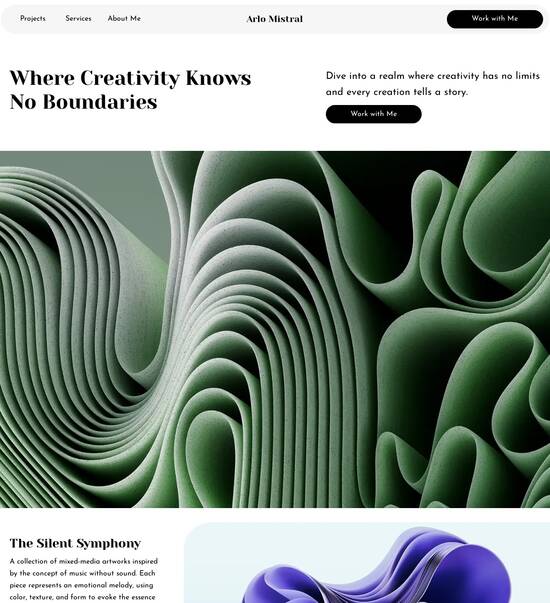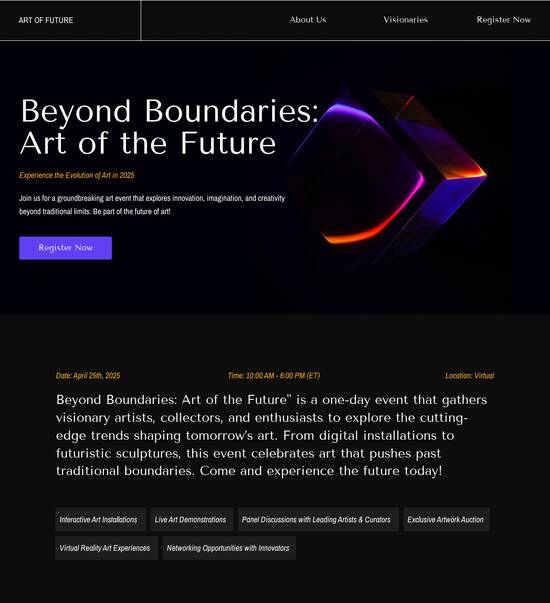
Web page template for Furniture Manufacturing
Use TemplateAbout template
Conquer your niche with our high-converting landing page templates for your Furniture Manufacturing business. Let's boost conversion rates together!
Recommended templates

Easy to build without coding
With the intuitive drag-and-drop builder, anyone on your team can create high-converting pages without any knowledge of code or design. Make enhancements to your landing page with custom widgets using Javascript, HTML/CSS, or third-party scripts.

Multiple layouts for any industry and goal
Select from 500+ landing page layouts built to boost conversions across industry-specific scenarios. Customize them by adjusting fonts, adding images, and generating on-brand content with the AI assistant. Quickly scale with Instablocks® and Global Blocks that you can save, reuse, and update globally.

Loads fast and looks polished on any device
Every template is responsive, which means they present professionally on any device and load blazingly fast with our Thor Render Engine. You can also power them up with Google AMP technology to deliver an unparalleled mobile experience and drive higher conversions.

Robust analytics & experimentation
Get real-time updates and reporting across all your devices, showing the number of visitors, conversions, cost-per-visitor, and cost-per-lead. Launch AI-powered experiments, run A/B tests, and use heatmaps to analyze user behavior, then optimize your landing page to maximize conversions.







Easy to build without coding
With the intuitive drag-and-drop builder, anyone on your team can create high-converting pages without any knowledge of code or design. Make enhancements to your landing page with custom widgets using Javascript, HTML/CSS, or third-party scripts.
Multiple layouts for any industry and goal
Select from 500+ landing page layouts built to boost conversions across industry-specific scenarios. Customize them by adjusting fonts, adding images, and generating on-brand content with the AI assistant. Quickly scale with Instablocks® and Global Blocks that you can save, reuse, and update globally.
Loads fast and looks polished on any device
Every template is responsive, which means they present professionally on any device and load blazingly fast with our Thor Render Engine.
Robust analytics & experimentation
Get real-time updates and reporting across all your devices, showing the number of visitors, conversions, cost-per-visitor, and cost-per-lead. Launch AI-powered experiments, run A/B tests, and use heatmaps to analyze user behavior, then optimize your landing page to maximize conversions.
All the features you need to build lead-generating landing pages
Explore more featuresLearn how to build top-performing landing pages for any goal
FAQs
Leading the way in building high-performing landing pages





A step-by-step guide to mastering Instapage for your digital marketing
Instapage is an essential tool for marketers looking to optimize their landing pages and increase conversion rates. In this guide, we will demonstrate how to effectively use the Instapage platform to create high-converting landing pages that maximize your marketing ROI. With numerous customizable templates and intuitive features, you can tailor your campaigns to meet your unique business needs.
Understanding landing pages and their importance
Landing pages are designed to capture visitor data and drive conversions. They serve as a focused entry point for your visitors to take action. By utilizing Instapage, you can create specialized landing pages that align with specific marketing efforts, enhancing user experience and increasing conversion rates. Below are three key benefits of dedicated landing pages:
- Enhanced targeting: Focus your messages on audience segments for improved engagement.
- Increased conversions: Tailored content drives better action from visitors.
- Simplified analytics: Monitor specific traffic and conversions on dedicated pages.
Steps to create your first landing page
Creating an effective landing page on Instapage is straightforward. Follow these initial steps to set up your page:
- Choose a template: Select from over 100 customizable templates that fit your campaign needs.
- Customize your content: Use drag-and-drop features to ensure your landing page meets your branding requirements.
- Set up integrations: Connect your page with your email marketing software or CRM for seamless lead capture.
Optimizing your landing page for conversions
Once your landing page is set up, optimization is crucial. Here are some tips to enhance conversions further:
- A/B testing: Use built-in experimentation features to test different headlines, CTA buttons, and designs.
- Utilize heatmaps: Analyze visitor behaviors to pinpoint where improvements can be made.
- Track metrics: Make use of the Instapage analytics dashboard to assess performance and refine your approach.
By following these strategies, you can turn your landing pages into powerful tools for capturing leads and boosting your marketing efforts.
In conclusion, leveraging Instapage's capabilities allows marketers to not only design stunning landing pages but also effectively optimize them for higher conversions. Experience the power of Instapage today!
Ready to take your campaign to the next level? Sign up for Instapage and start building high-converting landing pages now!
People also ask about Web page template for Furniture Manufacturing
Web page template for furniture manufacturing
Understanding the landscape of furniture manufacturing websites
The furniture manufacturing industry has undergone significant digital transformation in recent years. Traditional showrooms are steadily being complemented or replaced by online platforms that allow consumers to browse products from the comfort of their homes. This shift underscores the necessity of having a well-structured web page template that actively engages customers. A website primarily serves as a virtual storefront, providing essential information while facilitating transactions.
Key objectives of a successful furniture manufacturing website include showcasing products effectively, enhancing user experience, and streamlining the purchasing process. By placing emphasis on these elements, manufacturers can get their brand noticed while also improving customer satisfaction.
Essential features of furniture manufacturing web page templates
Intuitive website design is a critical feature for any furniture manufacturing web page template. Aesthetically appealing websites not only capture attention but also instill trust in consumers. The layout significantly impacts user engagement, with grid views often providing a comprehensive look at multiple products while list views help users focus on details. Enhancing navigation further by incorporating categorized menus—such as living room, bedroom, and office sections—could enrich user interaction.
Dynamic product displays are another essential consideration. Utilizing high-resolution images is vital in showcasing furniture effectively; customers are drawn to visuals that depict quality and detail. Incorporating features like 360-degree views and multiple angles, enables users to visualize products from different perspectives, fostering trust through realistic imagery and color accuracy. This level of detail can set a brand apart.
Intuitive website design prioritizes aesthetic appeal.
Grid vs. list views enhance product visibility.
Categorized navigation simplifies user experience.
Customization options to enhance user engagement
Offering personalization features is essential for elevating user engagement. A personalized furniture product configurator allows customers to customize dimensions, colors, and materials, enriching their shopping experience. This creates a unique selling proposition—customers can visualize their customized furniture pieces, increasing the likelihood of a sale.
Moreover, incorporating interactive design features such as augmented reality (AR) adds an innovative twist. AR can allow consumers to visualize how the furniture would fit within their existing space, giving them better confidence in their choices. Virtual room planners serve a similar purpose by letting users arrange selected furniture pieces, further enhancing the online shopping experience.
Optimizing the browsing experience with advanced search functionality
A powerful search functionality is pivotal in optimizing the browsing experience. Implementing user-friendly search tools, including filters for categories like style, price, and color, can help consumers narrow down their options quickly. Predictive search features further enhance usability by suggesting products as users type, significantly speeding up their decision-making process.
Additionally, tagging and categorizing products improve discoverability. A well-organized database helps customers filter through numerous furniture items seamlessly, ensuring they can effortlessly find what they are looking for.
User-friendly search tools enhance product discovery.
Predictive search speeds up decision-making.
Tags improve product visibility in search results.
Streamlining the ordering process
An efficient ordering process can significantly reduce cart abandonment rates. A simplified checkout system that guides users from selection to payment is crucial. Highlighting multiple payment options, such as credit cards, PayPal, and even financing options, can accommodate various customer preferences, making the buying process easier and more inclusive.
Moreover, providing order tracking and confirmation details can build trust and transparency. Customers should receive insights into order status and estimated delivery times, keeping them informed and engaged throughout the purchasing process.
Mobile-responsive design for diverse devices
In the current consumer landscape, mobile optimization is no longer optional—it's a necessity. A mobile-responsive design ensures that potential customers can browse effectively on smartphones and tablets. Every aspect of the website, including product images and feature descriptions, needs to be accessible and visually appealing on all devices.
Implementing adaptive design strategies can enhance user experience on different screen sizes, ensuring that customers from various platforms have a seamless experience when exploring your furniture offerings.
Leveraging data insights for continuous improvement
Utilizing analytics tools is essential for continuously improving the performance of furniture manufacturing websites. By tracking user interactions, businesses can gain valuable insights into preferences and behaviors. Identifying the most viewed categories or items can inform inventory planning and marketing strategies.
In addition to analytics, employing feedback mechanisms is crucial. Encouraging customers to leave reviews and ratings can unveil areas for improvement. Analyzing this feedback can lead to enhancements in design and product offerings, allowing businesses to cater better to their audience’s needs.
Showcasing the range and quality of furniture products
One of the pivotal roles of a furniture manufacturing website is to showcase the quality of its offerings. Highlighting the material and craftsmanship behind furniture items can enhance consumer trust. Detailed descriptions that convey the unique aspects of each piece can serve to educate customers about the value of the products they are considering.
Additionally, promotional features like seasonal offers, bundles, and limited-time discounts can encourage customers to make immediate purchases. Highlighting these promotions effectively can drive engagement and boost sales.
Building a community around furniture manufacturing
Creating engaging content is vital for building a community around a furniture manufacturing brand. Incorporating blogs that discuss furniture trends, care tips, and design inspiration can attract a loyal audience. Integrating user-generated content through social media not only showcases customer satisfaction but also fosters a sense of community.
Networking opportunities with interior designers and influencers can amplify visibility. Encouraging customers to share their furniture setups online enhances brand engagement, paving the way for organic growth and community development.
Future trends in furniture manufacturing websites
Looking ahead, emerging technologies will play a significant role in the furniture manufacturing sector. The potential of artificial intelligence (AI) in streamlining design and enhancing customer service cannot be overlooked. Furthermore, incorporating virtual reality (VR) technology into online platforms could provide immersive experiences, enabling customers to interact with products in novel ways.
Sustainability and ethical practices are also gaining traction in consumer preferences. Highlighting eco-friendly production methods and materials can resonate with environmentally-conscious shoppers. Providing opportunities for customers to support sustainable businesses may yield significant advantages in a competitive marketplace.
Ready to skyrocket conversions?
Supercharge your ad campaigns with high-performing landing pages
Get started














